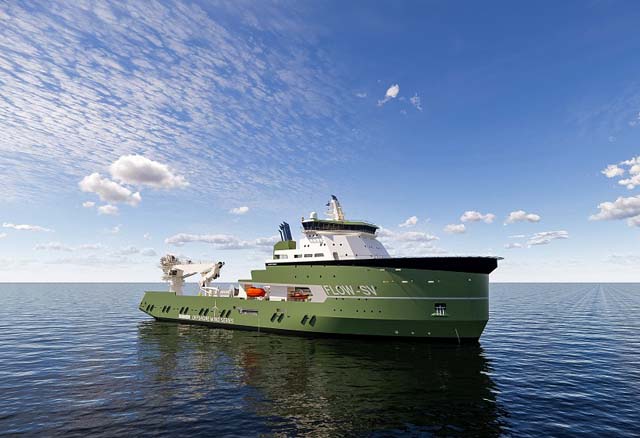Anticipating upcoming large-scale floating windfarm installation, Damen Shipyards has developed a vessel concept, Flow-SV, prepared for operation using methanol as fuel.
The Flow-SV is intended to accelerate the development of this new maritime segment being specially designed to install ground tackles for offshore turbine floaters. The vessel can load the immense lengths of chain needed to install and secure nine anchors or suction piles. Instead of mooring one floating windmill in a mission, three can be secured. It applies sufficient proof loading on the anchors to make the installation more efficient.
Wijtze van der Leij, Damen Sales Manager, said: “With the Flow-SV, we have developed a vessel which covers the entire process of attaching mooring lines. This vessel, combining the supply, installation, securing and inspection of the ground tackles for floating turbines in one vessel, introduces a big step forward towards large scale installation of floating windfarms. The concept reflects our expertise in operational demands and efficiency. At the moment, we are still in the concept phase. But we are now entering a stage where we would like to partner up to refine and customise this concept. Together with a launching customer, we aspire to accelerate the floating offshore windfarm installation industry.”
Measuring approximately 150m in length and a 32m beam, the Flow-SV is intended to accommodate the size and weight of anchors and chains needed for installing offshore floating wind turbines are too large for previous generations of anchor handling vessel. As the Flow-SV will be able to take all the materials and equipment needed to install three floaters, the vessel saves time on transits and loading. Secured at all three corners, a floater needs three ground tackles.
A feature of the Flow-SV is the combination of bollard pull generated by the thrusters and added pulling force from the bow reaction anchor winch. This adds up to 1,000t of proof load. The vessel deploys the bow anchor and embeds it by reversed bollard pull, and then moves to the spot where the anchor for the floater needs to be installed. After letting out enough chain length, the anchor for the floater needs to be proof loaded, ensuring a secure seabed connection. Using the four thrusters, Fow-SV has 400t of bollard pull. Pulling strength is enhanced by the forward anchor handling winch, that generates another 600t. At that moment, approximately 1,000t of proof-load is acting.
Two fixed propellers in nozzles and two azimuthing thrusters at the stern propel the Flow-SV and provide forward bollard pull. These propellers in nozzles turn 180 degrees to provide reverse bollard pull when the bow anchor is set. The azimuthing thrusters are engaged for dynamic positioning, together with the retractable azimuthing thruster and tunnel thrusters in the bow section of the vessel.
In line with the purpose of installing renewable energy supply, the FlowSV is laid out for using the renewable fuel methanol. Tanks and piping are in place according to safety regulations for this future fuel. Six generators feed the electric thrusters. When the floater anchors are being secured and maximum bollard pull is required, the two fixed 5.5m propellers in nozzles are engaged. At transit journeys between harbours and windfarm sites, the azimuthing 4.5m thrusters propel the vessel. This eliminates the need for rudders. All propulsion units are positioned to have the least possible interference with anchor chains.



